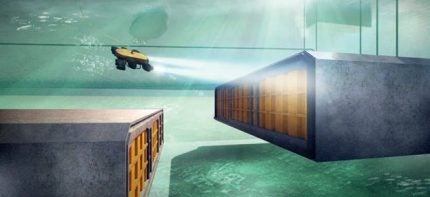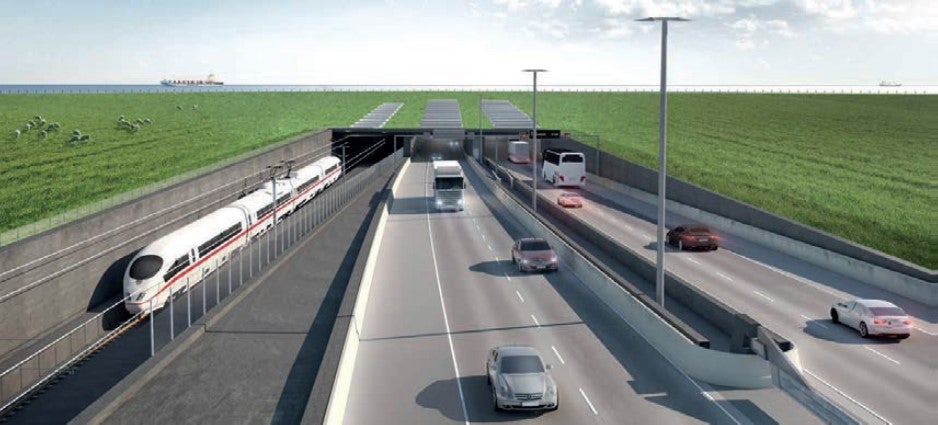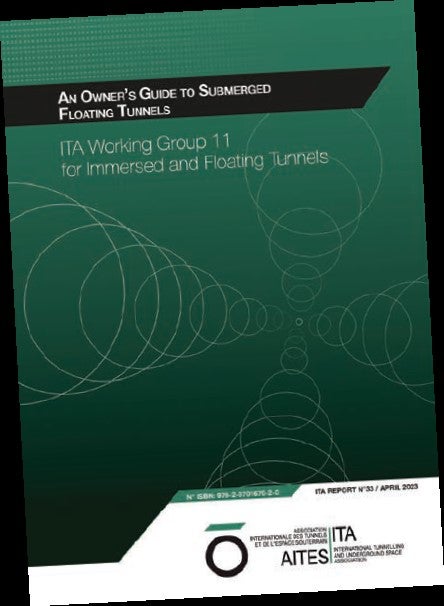
While there are many challenges in the design and construction of tunnels to be blasted or bored through hard rock, or those carved or pushed through soft ground, those are familiar to most tunnellers even as they might specialise in one type of tunnelling or another, or scale.
What is far less common is experience with the major prefabricated structures in concrete, steel, or indeed sandwiched combinations, built in lengths to be taken out to open water or sea and lowered to a sea trench, joined up into a whole coast-to-coast length, and then buried with protective soil and rock shielding.

Not all tunnellers work with immersed tube tunnels, or indeed are necessarily familiar with their fascinating challenges. Many have been built of varying lengths and, indeed, some world beaters are under construction presently. In general, they are infrequent projects but, like all tunnels, they are strategic underground links.
Yet there is a further ‘tunnel-out-in-water’ category that is even rarer and, so far, has remained conceptual and challenges for designers: submerged but floating tunnels, held in place and stabilised by various means, such as piers, pontoons, tethers or even shore anchoring. For the most part, unlike other tunnels their main structures are not in contact with the ground – but enveloped by water. None has been built, yet. In the past, prior discussions on such projects have grouped them under the heading ‘Strait Crossings’, and some rules and guidelines, and technical documents, referenced in the report discuss related buoyancy structures such as ‘Submerged Floating Tube Bridges’.
Both immersed tube tunnels built that already and those under construction now, and the conceptual systems to make the first floating tunnels by drawing upon technological advances in other sectors of industry, are hugely interesting engineering challenges. Arguably, by nature and necessity, they call for the most pre-construction planning and works in the tunnelling industry.

In the last two years the specialist team of the International Tunnelling and Underground Space Association (ITA) that looks at such ‘out-in-the-water’ projects – Working Group 11 (WG 11) – has produced consecutive reports that addressed each category of tunnel in turn: in 2022, immersed tube tunnels; last year, floating tunnels. The reports are Owner’s Guides.
FLOATING TUNNELS
The ITA report that is the Owner’s Guide to the status of floating tunnels was published in 2023. While noting that such a tunnel has yet to be built across a waterway, it says the report is to help potential owner’s consider how a floating tunnel could be an effective alternative to bridges and conventional tunnels.
The report aims to guide and support assessment toward determining a realistic, safe and economic assessment, and covers terms and definitions associated with floating tunnels, their general requirements, construction, operation, inspection and maintenance. In its listings it can been seen that most project concepts have anticipated using concrete technology for the floating tunnels, and sometimes composite structures. But the report can only be a brief guide to requirements for such new types of permanent waterway crossings, and as such the technical discussions are kept at a descriptive level only, as it notes.
It acknowledges that with no fixed floating tunnel in the field, the information draws from knowledge and experience of owners, researchers and project engineers who have worked on studies, plans and design concepts.
The guide also draws upon knowledge and experience won on immersed tube tunnel projects as well as from other industries where construction of major civil engineering infrastructure off the coastline or at sea have been accomplished, such as in the energy sector where oil & gas structures and renewables structures have been designed to be built offshore and then operate and endure.
But, while drawing upon the other sectors, floating tunnels have yet to prove the combination of those technologies at full scale, the reports notes.
With all that to cover in the still new field, the report does so succinctly in a report of only 24 pages that include eight chapters (two short, six longer) plus references. It does cover a number of the studied conceptual tunnel projects for specific locations, with key overview data (see box panel).
The listed projects have concepts of: dramatically varied lengths – barely 100m up to astounding proposed lengths of 30km, 70km and even 150km; highly varied depths of waterways to be crossed – from max 12m to 1200m; tighter bounding of positionings, below the water surface – with proposed max submergence from only 5m to almost 60m; and, stabilisation systems that range from tethers, mooring and pontoons to piles and pile-founded columns, and also free span and a variation of free-span with shore-anchorage.
A number of research centres examine the submerged floating tunnel concepts, with location including Norway, Italy, The Netherlands, Indonesia, South Korea, and China.
IMMERSED TUBE TUNNELS
The ITA report that is the Owner’s Guide to immersed tube tunnels was published in 2022, aiming to advise on what such an organisation needs to plan, execute and maintain such large structures on the seabed. It adds that while such tunnels are a specialist area with civil engineering, the Guide aims to demystify their complexities.
The report highlights that particular aspects and needs to approach immersed tube are focused upon rather than routing construction practices. While various ground conditions are discussed, and the broad differences between steel and concrete tube structures, the Guide doesn’t otherwise go into detail with specifics on sites or materials. It has been written as a general aid to Owners.
But it does add that identifying and “reliably” recording details of importance does merit the introduction of ‘instrumentation, documentation and verification (IDV).
The Guide aims to help Owners “to determine the important characteristics of their projects which require particular attention over the life of the tunnel.” It is to be a tool to understand “key risks and issues” and then implement a system to address and control them, and so support engagement with expert advisors.
With so much packed it, it is still a short Guide – only 12 pages in the main document, focused mainly on general themes and IDV. But it has a very long and substantial accompanying Annexe – of 148 pages. The Annexe has a glossary of terms, and also 37 themes ranging from structures, joints and seals, to loads, transport, alignment, and also fire safety and ventilation, and many more – including project management and contracts.
The Annexe has much detail in its discussions and the pages are well illustrated with multiple supporting examples plus references to a number of built immersed tube tunnels around the world over recent decades.
FLOATING TUNNELS – CONCEPT PROJECTS
Among the many referenced floating tunnels that were developed as concept projects over the years are referenced in ITA’s Owner’s Guide report, published in 2023, are:
- Bjørnafjord: conceived to be a 5.5km-long concrete tunnel held up to some 30m below water surface by tensioned tethered mooring (stabilisation against vertical and/or horizontal motion) or pontoon supports. The fjord is up to 580m deep.
- Breisundet: of a similar concept also in concrete although shorter, at 4.2km length – still a tremendous length; and with positioning similarly below the surface, again with tensioned tethers (but inclined).
- Daikokujima: relatively, a very short crossing of 100m, in 12m max depth of water, with a structure of concrete and steel, and held stationary with inclined mooring.
- Digernessundet: short compared to the multi-kilometre long concepts tunnels but still long in its own right for this technology, at a proposed 520m length and running up to 40m below the water surface in a body up to 200m deep. This floating concrete tunnel structure would be stabilised by a different mechanism: a free span structure that is shore-anchored (likely a neutrally buoyant tube tunnel that acts like a beam, fixed at the shores).
- Dikket pontonbro: no data, but noted to be stabilised by tension tethers and pontoons.
- Drøbaksundet hybrid bridge: no data either, but concept with mooring stabilisation.
- Eldfjord: no details on this 1.2km-long proposed structure, but its alignment was to cross a water body up to 250m deep by running at more than 16m depth below the surface and held in place by inclined tethers
- Gulf of California: an incredible proposed length of 150km is listed, for a concrete tube to cross water up to 213m deep at up to 25m below the surface, and stabilised with inclined moorings.
- Jintang Strait: a 3.2km-long concrete tunnel across a waterway up to 100m depth, and stabilised with inclined mooring to run up to 25m below the surface.
- Osaka Bay: an 11km-long proposed floating concrete tunnel crossing slightly deeper than mid-depth of water up to 40m depth, and supported on steel piles
- Sulafjord: a 3.64km-long crossing of water up to 440m depth, the concrete or steel tunnel located up to 58m below the water surface, and anchored by tethers.
- Sognefjord: a concept of a 3.7km-long concrete tunnel supported by pontoons as it crosses a fjord up to 1200m deep while running up to 20m below the water surface. Pontoons stabilise vertical motion, with local horizontal loading conditions minor on the tube tunnel that is expected to be neutrally-bouyant.
- Tubolario: a proposed length of an increasable 70km, across water up to 418m deep, and stabilised with tethers
Other projects listed include Funka Bay, Høgsfjord, Lake Lugano, Messina Strait, Oinaoshi In-Port, Lac Leman, Qiandao Lake, Qiongzhou Strait, Rovdefjord, and Seribu Archipelago.






